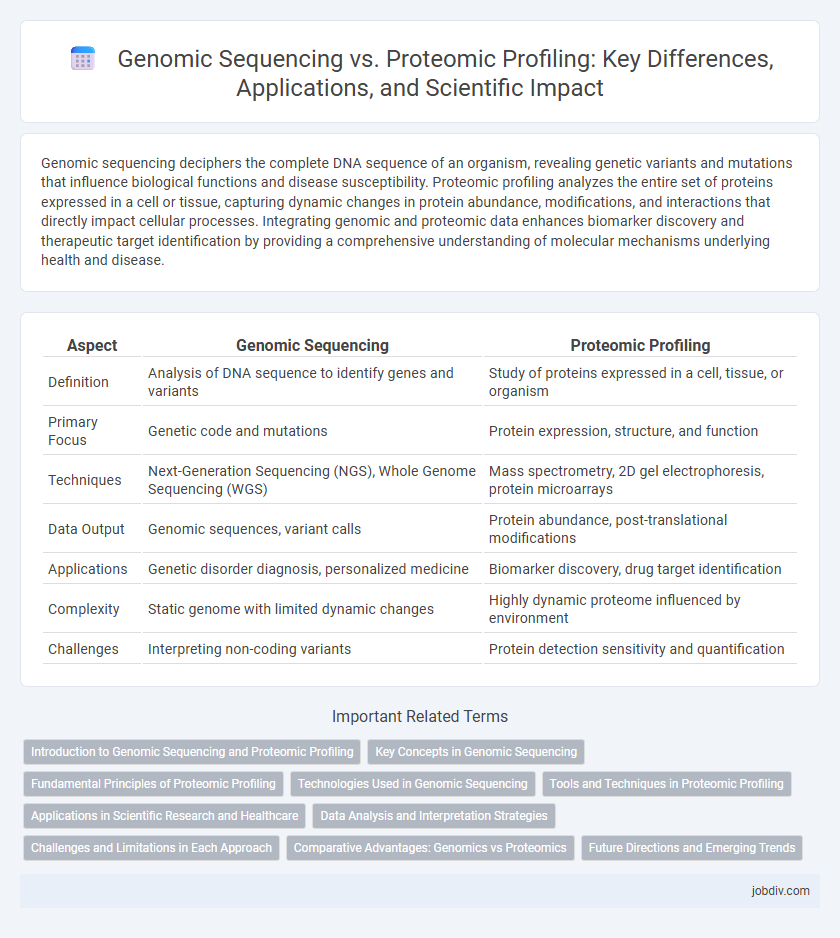Genomic sequencing deciphers the complete DNA sequence of an organism, revealing genetic variants and mutations that influence biological functions and disease susceptibility. Proteomic profiling analyzes the entire set of proteins expressed in a cell or tissue, capturing dynamic changes in protein abundance, modifications, and interactions that directly impact cellular processes. Integrating genomic and proteomic data enhances biomarker discovery and therapeutic target identification by providing a comprehensive understanding of molecular mechanisms underlying health and disease.
Table of Comparison
| Aspect | Genomic Sequencing | Proteomic Profiling |
|---|---|---|
| Definition | Analysis of DNA sequence to identify genes and variants | Study of proteins expressed in a cell, tissue, or organism |
| Primary Focus | Genetic code and mutations | Protein expression, structure, and function |
| Techniques | Next-Generation Sequencing (NGS), Whole Genome Sequencing (WGS) | Mass spectrometry, 2D gel electrophoresis, protein microarrays |
| Data Output | Genomic sequences, variant calls | Protein abundance, post-translational modifications |
| Applications | Genetic disorder diagnosis, personalized medicine | Biomarker discovery, drug target identification |
| Complexity | Static genome with limited dynamic changes | Highly dynamic proteome influenced by environment |
| Challenges | Interpreting non-coding variants | Protein detection sensitivity and quantification |
Introduction to Genomic Sequencing and Proteomic Profiling
Genomic sequencing deciphers the complete DNA sequence of an organism, enabling the identification of genetic variants linked to diseases, traits, and evolutionary patterns. Proteomic profiling analyzes the entire set of proteins expressed by a genome, revealing dynamic information about protein structure, function, and interactions under various conditions. These complementary approaches provide insights into molecular biology by mapping genetic codes and their functional protein products.
Key Concepts in Genomic Sequencing
Genomic sequencing involves determining the complete DNA sequence of an organism's genome, enabling the identification of genes, mutations, and structural variations critical for understanding hereditary conditions and disease mechanisms. Key concepts include next-generation sequencing (NGS) technologies, which allow high-throughput and precise analysis of genetic information, and bioinformatics tools essential for interpreting vast amounts of sequence data. This approach contrasts with proteomic profiling, which analyzes the protein expressions and modifications that reflect genomic information at the functional level.
Fundamental Principles of Proteomic Profiling
Proteomic profiling analyzes the complete set of proteins expressed by a genome, capturing dynamic post-translational modifications and protein interactions absent in genomic sequencing. This approach relies on mass spectrometry and bioinformatics to quantify protein abundance, structure, and function within specific biological contexts. Unlike static DNA sequences, proteomic profiling provides functional insights critical for understanding cellular mechanisms and disease states.
Technologies Used in Genomic Sequencing
Genomic sequencing employs high-throughput technologies such as next-generation sequencing (NGS), whole-genome sequencing (WGS), and single-molecule real-time (SMRT) sequencing to decode DNA at unprecedented speed and accuracy. These platforms enable comprehensive analysis of genetic variants, structural rearrangements, and epigenetic modifications across entire genomes. Advances in sequencing chemistries, bioinformatics algorithms, and automated workflows have significantly enhanced data quality and reduced costs, driving large-scale genomic studies and personalized medicine initiatives.
Tools and Techniques in Proteomic Profiling
Proteomic profiling utilizes advanced tools such as mass spectrometry, two-dimensional gel electrophoresis, and protein microarrays to analyze protein expression, modifications, and interactions comprehensively. Techniques like tandem mass spectrometry (MS/MS) enable high-throughput identification and quantification of proteins, providing detailed insights into cellular functions and disease mechanisms. These tools surpass genomic sequencing by revealing dynamic protein landscapes that directly reflect physiological states and cellular responses.
Applications in Scientific Research and Healthcare
Genomic sequencing provides comprehensive analysis of DNA, enabling identification of genetic variants and inherited disorders crucial for precision medicine and targeted therapies. Proteomic profiling offers insights into protein expression, modification, and interactions, facilitating biomarker discovery and understanding of disease mechanisms at the functional level. Integrating genomic and proteomic data enhances personalized treatment strategies, drug development, and diagnostics by capturing both genetic information and dynamic proteome changes in health and disease.
Data Analysis and Interpretation Strategies
Genomic sequencing generates vast nucleotide data requiring bioinformatics tools like variant calling and genome annotation to identify genetic mutations and structural variations. Proteomic profiling relies on mass spectrometry data analyzed using algorithms for peptide identification, quantification, and pathway mapping to elucidate protein expression and post-translational modifications. Integrative computational approaches combining genomics and proteomics enhance functional interpretation by correlating gene variants with protein activity and biological outcomes.
Challenges and Limitations in Each Approach
Genomic sequencing faces challenges such as the vast complexity of interpreting non-coding regions and variants of uncertain significance, limiting its ability to predict phenotypic outcomes accurately. Proteomic profiling is constrained by the dynamic nature of protein expression, post-translational modifications, and the difficulty in detecting low-abundance proteins, which complicates comprehensive proteome coverage. Both approaches are limited by technological sensitivity and the need for integrative analysis to fully understand biological systems.
Comparative Advantages: Genomics vs Proteomics
Genomic sequencing offers comprehensive insights into the complete DNA blueprint of an organism, enabling identification of genetic variants and hereditary traits with high accuracy. Proteomic profiling, in contrast, provides dynamic information on protein expression, modifications, and interactions, reflecting real-time cellular states and functional outcomes. The integration of genomic data with proteomic analysis enhances understanding of molecular mechanisms underlying diseases, optimizing biomarker discovery and targeted therapeutic development.
Future Directions and Emerging Trends
Emerging trends in genomic sequencing emphasize the integration of long-read technologies and real-time data analysis to enhance variant detection and personalization of medicine. Proteomic profiling advances leverage high-throughput mass spectrometry and single-cell proteomics to map dynamic protein interactions and post-translational modifications with unprecedented resolution. Future directions point toward multi-omics integration combining genomics, proteomics, and transcriptomics to provide comprehensive molecular insights for precision diagnostics and targeted therapies.
Genomic Sequencing vs Proteomic Profiling Infographic

 jobdiv.com
jobdiv.com